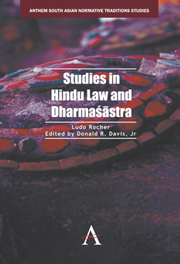Book contents
- Frontmatter
- Contents
- Foreword by Richard W. Lariviere
- Preface
- Abbreviations
- Note on the Edition
- Introduction
- PART ONE THE NATURE OF HINDU LAW
- Hindu Conceptions of Law
- The Historical Foundations of Ancient Indian Law
- Hindu Law and Religion: Where to Draw the Line
- Law Books in an Oral Culture: The Indian Dharmaśūstras
- Schools of Hindu Law
- Changing Patterns of Diversification in Hindu Law
- PART TWO GENERAL TOPICS OF HINDU LAW
- PART THREE HINDU LEGAL PROCEDURE
- PART FOUR TECHNICAL STUDIES OF HINDU LAW
- PART FIVE ANGLO-HINDU AND CUSTOMARY LAW
- Bibliography
- Index
Schools of Hindu Law
from PART ONE - THE NATURE OF HINDU LAW
Published online by Cambridge University Press: 05 February 2013
- Frontmatter
- Contents
- Foreword by Richard W. Lariviere
- Preface
- Abbreviations
- Note on the Edition
- Introduction
- PART ONE THE NATURE OF HINDU LAW
- Hindu Conceptions of Law
- The Historical Foundations of Ancient Indian Law
- Hindu Law and Religion: Where to Draw the Line
- Law Books in an Oral Culture: The Indian Dharmaśūstras
- Schools of Hindu Law
- Changing Patterns of Diversification in Hindu Law
- PART TWO GENERAL TOPICS OF HINDU LAW
- PART THREE HINDU LEGAL PROCEDURE
- PART FOUR TECHNICAL STUDIES OF HINDU LAW
- PART FIVE ANGLO-HINDU AND CUSTOMARY LAW
- Bibliography
- Index
Summary
“The Dayabhaga school prevails in Bengal; the Mitakshara school prevails in the rest of India…One of the main differences between these two principal schools of Hindu law relates…to the law of inheritance” (Mulla 1970: 45). This statement in a highly respected volume on Hindu law can be found in some form or other in all treatises on Hindu law, in many judicial decisions, etc. In fact, the concept of “schools of Hindu law” has become so universally accepted, that it has rarely been objected to in the past and is hardly ever questioned today. When Julius Jolly presented the Tagore Law Lectures in 1883, he considered that he could dispose of the problem with these words: “The notion of Indian Schools of law has been objected to on general grounds, but these objections have been so well refuted by former Tagore Law Professors that I have nothing to add to their arguments” (Jolly 1885: 17; the two Tagore Law Professors referred to are G.D. Banerjee and R. Sarvadhikari).
Yet, it is a well-known fact that the term “schools” was first applied to Hindu law by H.T. Colebrooke (1765–1836). In a reply to an anonymous critic Colebrooke clearly defends the term as his own invention: “I am yet to learn why schools are to be restricted to matters of taste and the fine arts; or why jurisprudence is not to be taught and studied in schools.
- Type
- Chapter
- Information
- Studies in Hindu Law and Dharmasastra , pp. 119 - 128Publisher: Anthem PressPrint publication year: 2012



